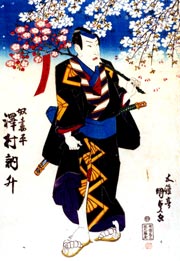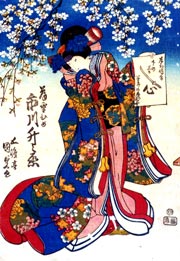| HANAMI |
| Play title | Shin Usuyuki Monogatari |
| Authors | Matsuda Bunkôdô Miyoshi Shôraku Takeda Koizumo I (Takeda Izumo II) Ogawa Hanbei |
| History |
The play "Shin Usuyuki Monogatari" was originally written for the puppet theater (Bunraku) and staged for the first time in the 5th lunar month of 1741 in Ôsaka at the Takemotoza. It was adapted for Kabuki a few months later and staged for the first time in the 8th lunar month of 1741 in Kyôto at Hayagumo Chôdayû's theater, produced by Sakakiyama Jûtarô I [casting]. The "Hanami" scene was performed for the first time with the actors Tamiya Jûzaburô I, Kikugawa Kiyotarô, Sakakiyama Shirotarô I, Takenaka Heikichi, Sakakiyama Danshirô I and Arashi Tatsusaburô in the roles of the yakko Tsumahei, Princess Usuyuki, Dankurô, Sonobe Saemon, Akizuki Daizen and Magaki. |
| Structure |
"Shin Usuyuki Monogatari" was originally a 3-part drama. The current version is now made up of 4 acts (divided into 7 scenes). "Hanami", the "Cherry Blossom Viewing", is the nickname of the first act (made up of only 1 scene). It was originally the last scene of the first part of "Shin Usuyuki Monogatari". |
| Key words | Gidayû Kyôgen Giri/Ninjô Jidaimono Tachimawari Hanami |
| Summary |
Shin Kiyomizu Hanami ("Cherry Blossom Viewing at Kiyomizu") It is a glorious spring day in Kyôto. Princess Usuyuki and her ladies come to the Kiyomizu Temple to view the blossoming cherry trees that are now at their height. Her chief serving lady is called Magaki. On a poetry slip, Usuyuki composes a poem referring to the flowers and this is attached to a branch of a cherry tree before she and her party continues onto the upper terrace in front of the temple. Soon, a handsome young samurai by the name of Sonobe Saemon also arrives here. He is on an official mission to dedicate a precious sword to the temple on behalf of the shogun. He is accompanied by Tsumahei, his yakko footman, and a famous swordsmith named Rai Kuniyuki who made the sword. Once the ceremony is over, Saemon sees the poem written by Usuyuki and, greatly admiring it, cuts off the branch to which it is attached. This is seen by Usuyuki from the distance and Magaki approaches the men to ask for the poem’s return. Usuyuki then begins another poem but declares that she cannot finish it, at which Magaki takes the poem to Tsumahei for him to pass on to his master. The men are to complete the verse. At first, Tsumahei himself attempts to do this but fails miserably, in a comic scene. At last, it reaches Saemon who successfully completes the poem. When this is returned to Usuyuki, her serving lady suggests that she thank Saemon, but Usuyuki is too overcome with embarrassment for she has fallen in love with him. Eventually, Magaki goes back to Saemon to inform him that Usuyuki wants to become his wife. In fact, Saemon also loves Usuyuki, but he makes a show of protesting that she is too far above him in station for such a union to be considered. Magaki must call upon Tsumahei to help out, and both are anxious for the match to take place. Magaki and Tsumahei are also in love with each other. At last, Magaki persuades Usuyuki that she must force Saemon to accede by saying she will kill herself if he does not. The ploy works, and Saemon consents to marry her. Saemon is summoned to the temple. Again, at Magaki’s instigation, Usuyuki writes a letter to Saemon inviting him to visit her secretly and this is attached to another branch. When Saemon sees it, he promises to obey. Usuyuki withdraws into the temple to pray, and Magaki is left alone. Just then, Shibakawa Tôma, a retainer of the arch villain Akizuki Daizen appears, and tries to make love to Magaki. Declaring that she loves only Tsumahei, she beats Tôma off and escapes. Tôma guesses that if that is the case, then Magaki’s mistress Usuyuki is most probably in love with Saemon, and so getting rid of Saemon would be a good idea since it would leave Tsumahei without employment and therefore unable to form an attachment with Magaki. He decides to await an opportunity to kill Saemon soon. For a swordsmith, the order to make the sword presented to the temple is a great honour, and another great swordsmith by the name of Masamune Dankurô is jealous that the honour was given to Rai Kuniyuki. He now appears with the sword that he has stolen. Taking out the blade, he marks and places a curse upon it. This is seen by Rai Kuniyuki who comes out to accuse Dankurô of the crime. In the ensuing struggle between them, Dankurô kills Kuniyuki. Just then, appearing from out of the temple is the villain Daizen, accompanied by Tôma. It turns out that the order to mark and curse the sword was Daizen’s. In fact, Daizen lusts after Princess Usuyuki himself and when he sees Usuyuki’s letter to Saemon that is still attached to a tree he is filled with rage. After instructing Tôma to spy on Usuyuki, he departs, taking the letter with him. Just as Tôma tries to find out if Saemon and Usuyuki are still together, Magaki returns. When he attempts to seduce her again, Tsumahei comes to her rescue and he and Tôma begin to fight. Enlisting the help of a crowd of minor soldiers, Tôma threatens to douse Tsumahei and kill him. A magnificent and famous tachimawari fight scene follows as Tôma’s men try to get the better of Tsumahei but are eventually routed. Tôma then attacks him on his own and the curtain is drawn as they fight. Courtesy of Paul M. Griffith |
 |
 |
 |
|
The actors Sawamura Tosshô I, Ichikawa Masunojô and Ichikawa Danjûrô VIII
playing the roles of the yakko Tsumahei, Princess Usuyuki and Sonobe Saemon in the "Hanami" scene of
the drama "Toki-ni Saiwai Sakura no Irodoki", which was staged in the 3rd lunar month of 1839 at the Kawarasakiza |
||
|
|
| Contact | Main | Top | Updates | Actors | Plays | Playwrights | Programs | Links | FAQ | Glossary | Chronology | Illustrations | Prints | Characters | Derivatives | Theaters | Coming soon | News |